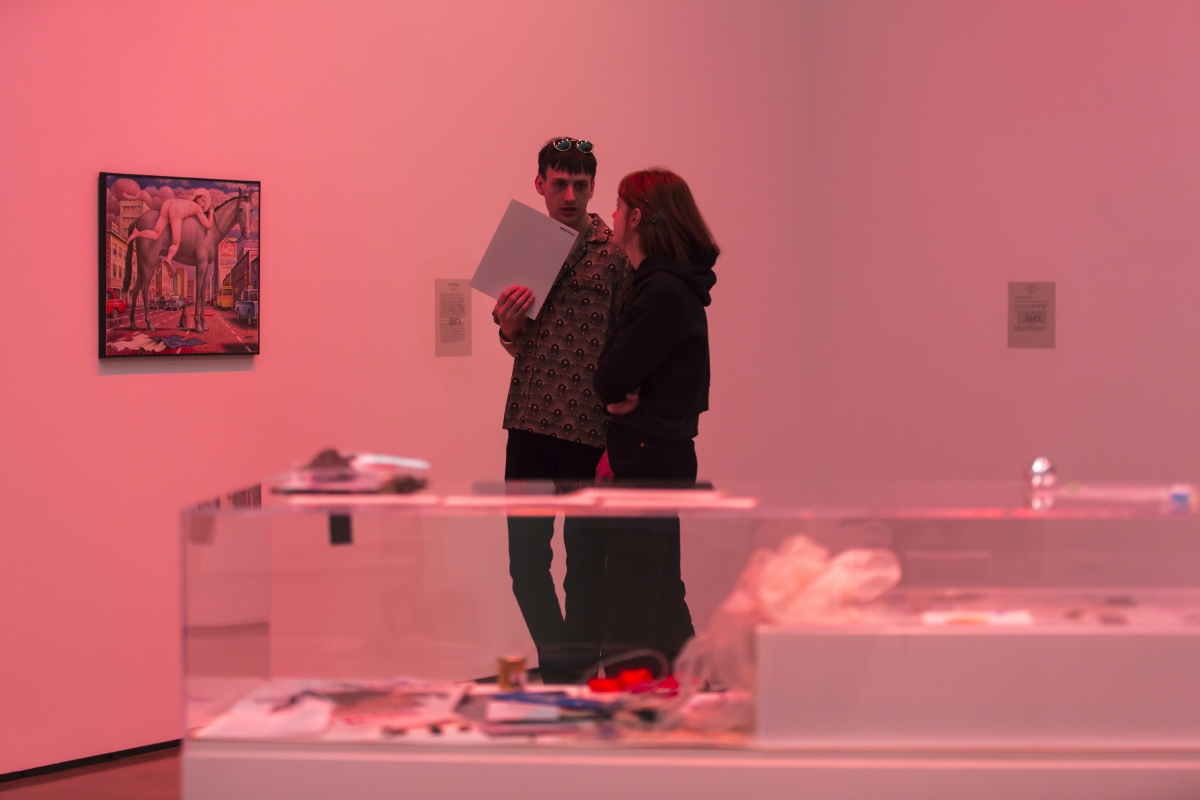Balticana: A fictive non-state agent of the Baltics. Balticana[1]. An allegorical pastiche of Baltic imagination — a fabricated adaptation where things like the new Soviet world order, romantic style, and cultural stereotypes of alcohol consumption parlay into a confusing, primary (self) identification. Balticana is a state of mind. It is a newlywed in traditional Baltic garb throwing an array of flowers into the air for you to catch, a fully Soviet organism which condenses geopolitics, nationalism, an unprocessed past, and a postmodern future into itself.
Cast in the dampened pale-red glow of infrared and ultraviolet lights is Balticana. The exhibition features works by artists Ilya Lipkin, Auseklis Baušķenieks, Vytautas Jurevicius, Peter Fend, and Collier Schorr, among others. It is unabashedly dense and poetic, requiring a degree of patience to uncover. Like a polyglot ambassador of Northern Europe, Balticana operates on multiple dimensions: an institutional dimension, a material dimension, and a phenomenological dimension. It is the brain-child of Zane Onckule, whose personal experience as a Riga-based curator educated in the United States are woven into the construction of the exhibition, played out in the performance of Baltic emancipation through caricature and fiction.
Immediately upon entering Balticana a viewer is presented with an exhortation: enter PORTAL, a mediation of the gallery space which designates it as a provisional construction site for transnational and personal histories. PORTAL is an architectural intervention consisting of a light-work intervention by BRUD called Black and White and Red All Over (2018), a sound installation with leftover performance props by Vytautas Jurevicius called Is Happiness an Illusion (2019), and a series of symbolic “door jams” wrapped around the walls of the entrances into the exhibition. PORTAL is also an invitation to re-enter the exhibition according to six different dramaturgical set-ups. The arrangements correspond to the six twentieth-century Baltic Dramas: The National, the Philosophical, the Historical, the Contemporary, the Absurd, and the Postcolonial. These enable a viewer to re-enter in search of a new metafiction; “the theme of today’s viewing is Absurd.” Signalling entry into a distinct headspace, the magical realism of Balticana begins here.
Presented under the guise of PORTAL, the works in Balticana feel more like symbols of diverse aesthetic expressions than they do samples of a prechewed motif. Culture roleplay is displayed through works acting as agents of territory-culture. Take Collier Schor’s Americans #1 (2012), which blurs supremacy into stereotype and dominion into authorship. The work depicts a young, white cowboy laid atop a patchwork of images of four elderly Black men. Two of the men’s faces have been obscured by the harsh collage, replacing the possibility of viewing their expressions with the outward, humorless gaze of the young cowboy. He breaks the fourth wall and gazes out, while the men beneath his superimposed image look laterally, across the foreground of the collage. Americans #1 emphasises the vertices of the gaze relative to culturally-embedded indicators. Crucially, though, this is a gesture about the violence inherent to the operation of looking. A viewer enters the asymmetrical gaze from the outside, directly engaging with the cowboy but looking passively at the Black men. In the context of Balticana, this lapse into hegemonic viewing affirms its kinship with Americana.
Another work stands out for its cultural roleplay, except in the reverse. I Want to Get on My Horse (1995) by Auseklis Baušķenieks depicts a naked male figure slumped over a horse on Riga’s busy Brīvības street. Newfangled company signposts (“LATRUS”; “AMERLAT”) can be made out in the background, marking a transition into the new status-quo of capitalism. It is unclear whether the protagonist — who appears to be an otherworldly anachronism — has just climbed onto the horse or fallen off of it. The painting is a cautionary tale, hinting at the only two options available to citizens in the aftermath of the collapse of the Soviet system: either you shift to the new world order, or you don’t. (Curiously, the owner of the work, Jānis Zuzāns, is a visible art collector in Riga who has benefited himself from Riga’s forced industrialisation. A napkin branded with his successful gambling business can be found elsewhere in the exhibition—a nod to Balticana’s self-referential and intimate construction.)
The highlight of Balticana is the ‘bespoke’ curatorial intervention at its centre. The two-pronged display consists of a freestanding sawhorse table slotted together with wooden pegs (the provisionally constructed table is intended to reference the makeshift aesthetic of 1990s Baltic households) and a more typical vitrine — white, polished, and museological. Each display piece hosts material amounting to a fictive archive of the national imaginary of ‘Balticana’. The items featured are symbolic of one facet of the Baltic imaginary, usually some combination of stereotype and allegory. There is a vinyl record by American musical artist Ben Zimmerman called The Baltika Years; a set of antique buttons from Imperial Russia, the Soviet Union, and the first republic of Latvia; commemorative red ribbon from the inauguration of the Latvian Institute in Rome; a bottle of Borjomi Georgian sparkling water; a stone from the Bard college campus where the curator went to school; a simulacrum of the curator’s thesis; an ID-card reader and pot of honey that was distributed as promotional material during the Estonian Parliamentary Election; and more. Together they amount to a spatialised, material circus — a performance of the cobbled-together self-identification of statehood. The gruffness of the assemblage, as well as the inclusion of militarised commodities, draws attention to the perennial problem haunting the Baltics and Eastern Europe: an unwillingness to identify with colonialism, adopting instead an ideology of superiority to other colonised peoples.
This negotiation of doubles realities is arguably the methodology underwriting Balticana and the parafiction governing post-Soviet life. The work here was to put on display that fictional imaginaries and vexing self-identification actually parlay into archived, collective memory, and that the collective memory of some — state agents, or oligarchs — is louder than the personal experiences of others. The history of the region is a history of continual power renegotiations, and conquest has caused emerging forces to usurp the land time and time again. Balticana caricatures this phenomenon and the coded ethnic racism that has come with it. It boasts the dramaturgy of the Balts, the presumptions of ethnic codes, and the bizarre self-identification of an equally emotional, equally contradictory history. It is a fully fabricated but truer-to-the-original choreography that combines tradition, subculture, and the curator’s own personal affinities with bleak nostalgia. It is an invented expression where “reality is treated in terms of imaginary identification and fantasy, arguments line up as they please, and humor is served as a nervous giggle.”[2] Balticana is the recognition that a “national imaginary” and individual agency are impossible to reconcile and yet, you can have both. Parafiction is not a glitch in the creation of geopolitical reality; instead, it is a fundamental tool of its formation.
[1] Balticana was on view on April 7 – May 26, 2019 at the Hessel Museum of Art, Annandale-on-Hudson, New York.
[2] Zane Onckule, “Balticana”, (Master’s thesis, Center for Curatorial Studies at Bard College, 2019).
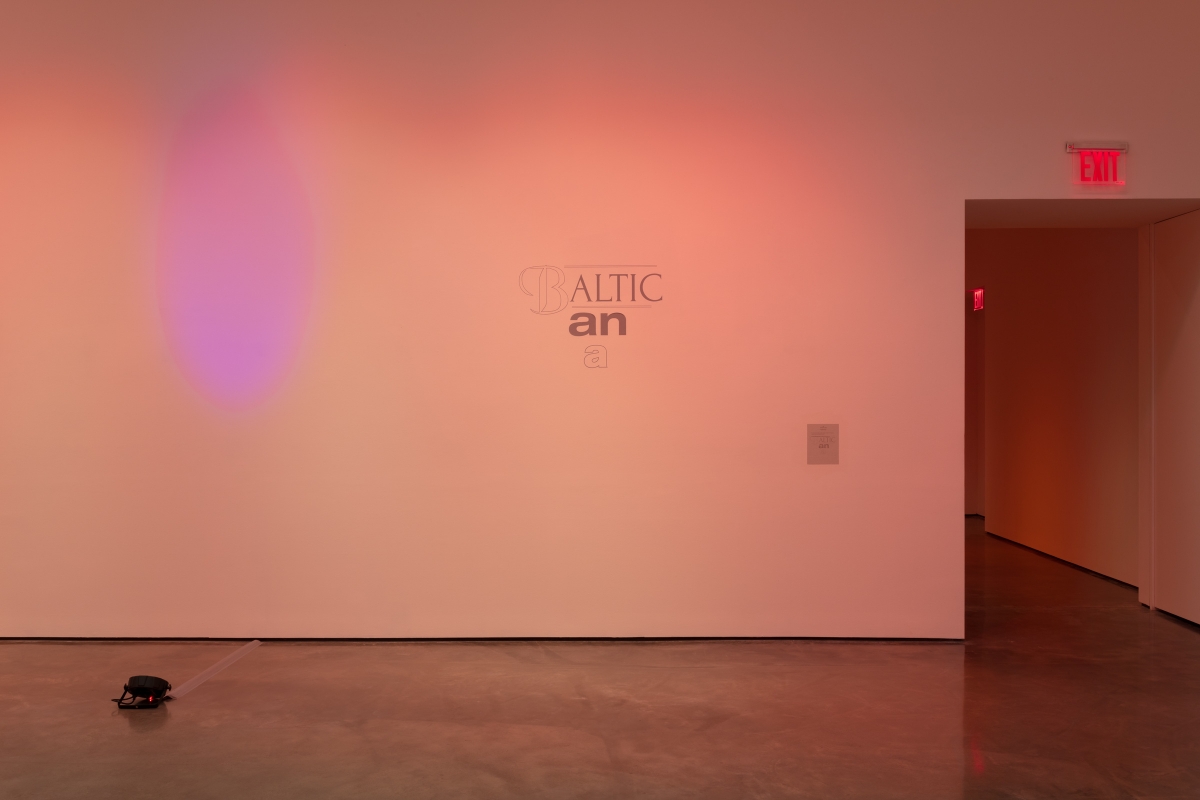
Installation view Balticana, Hessel Museum of Art, Photo: Pierre Le Hors 2019.

Installation view Balticana, Hessel Museum of Art, Photo: Pierre Le Hors 2019.
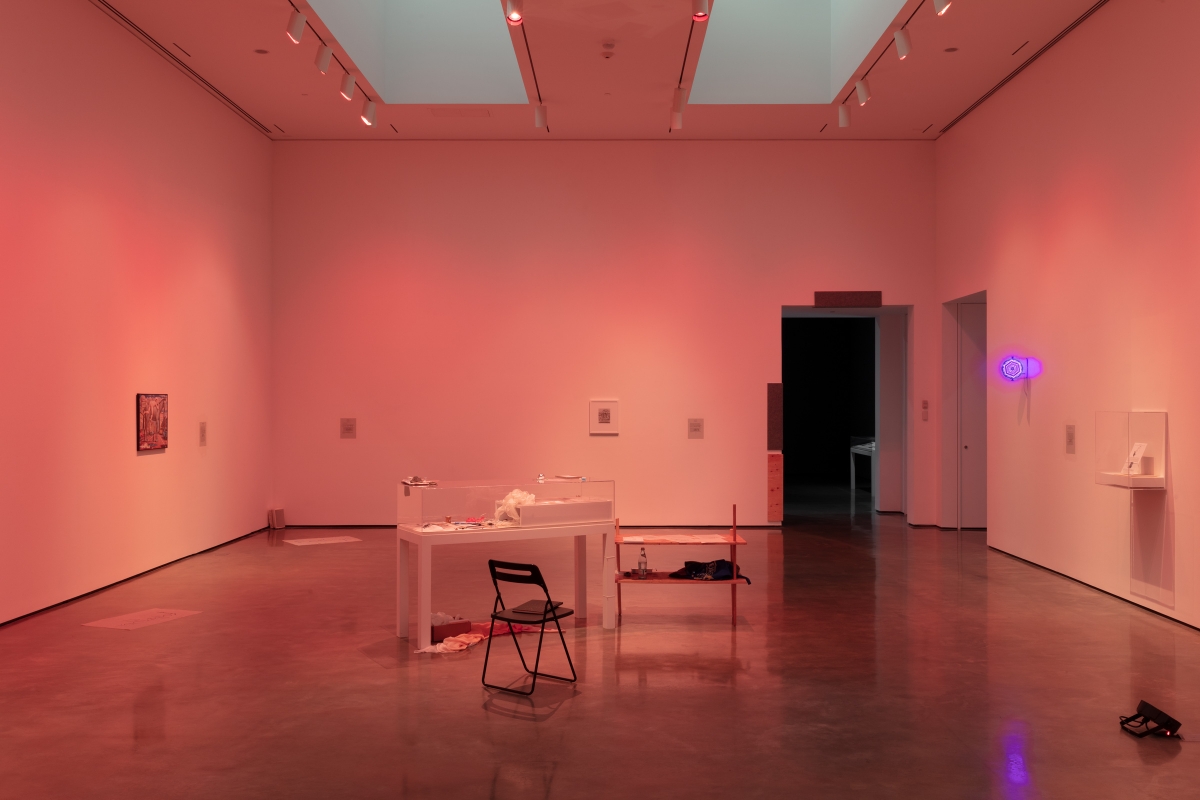
Installation view Balticana, Hessel Museum of Art, Photo: Pierre Le Hors 2019.
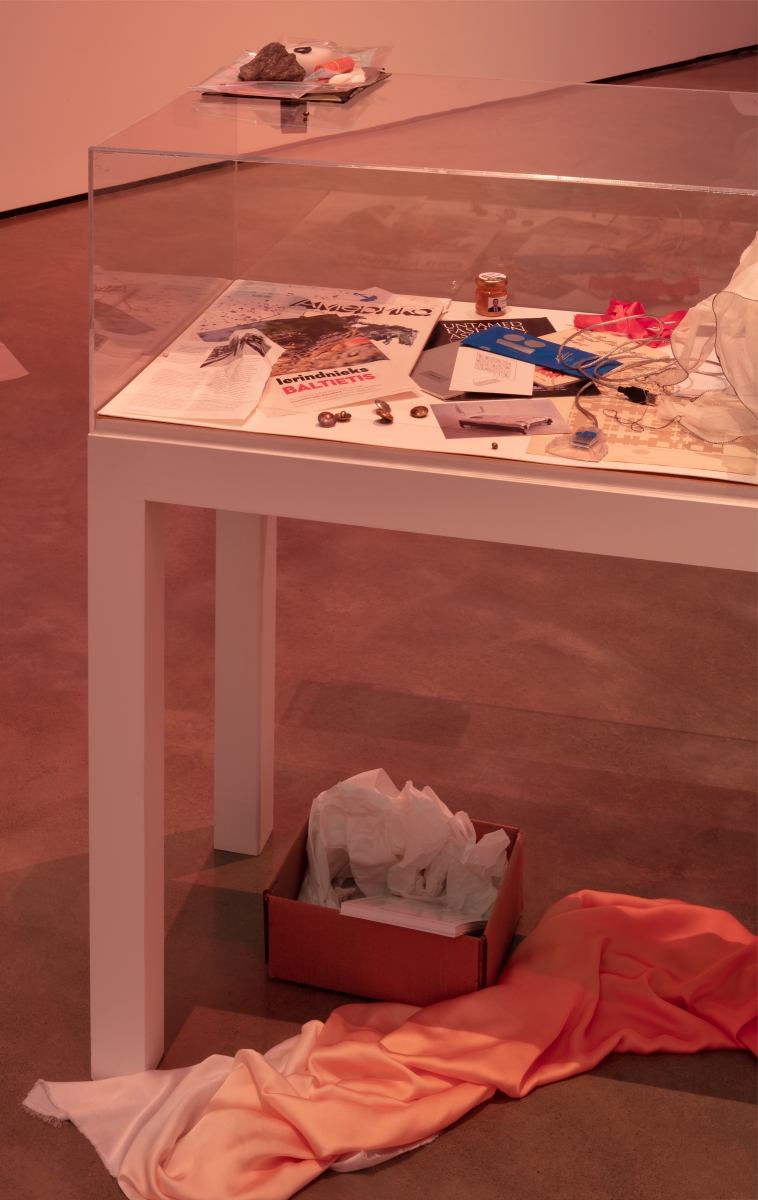
Installation view Balticana, Hessel Museum of Art, Photo: Pierre Le Hors 2019.

Installation view Balticana, Hessel Museum of Art, Photo: Pierre Le Hors 2019.
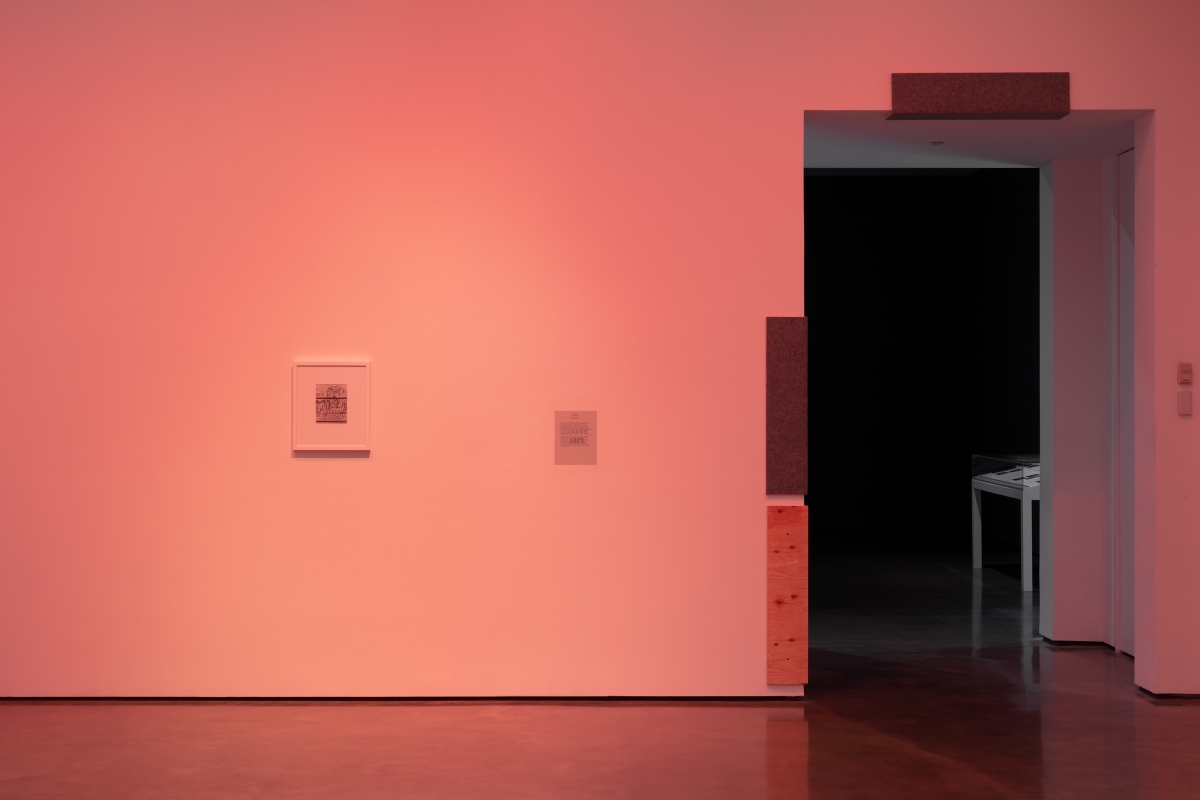
Installation view Balticana, Hessel Museum of Art, Photo: Pierre Le Hors 2019.

Installation view Balticana, Hessel Museum of Art, Photo: Pierre Le Hors 2019.

Installation view Balticana, Hessel Museum of Art, Photo: Pierre Le Hors 2019.

Installation view Balticana, Hessel Museum of Art, Photo: Pierre Le Hors 2019.

Installation view Balticana, Hessel Museum of Art, Photo: Pierre Le Hors 2019.
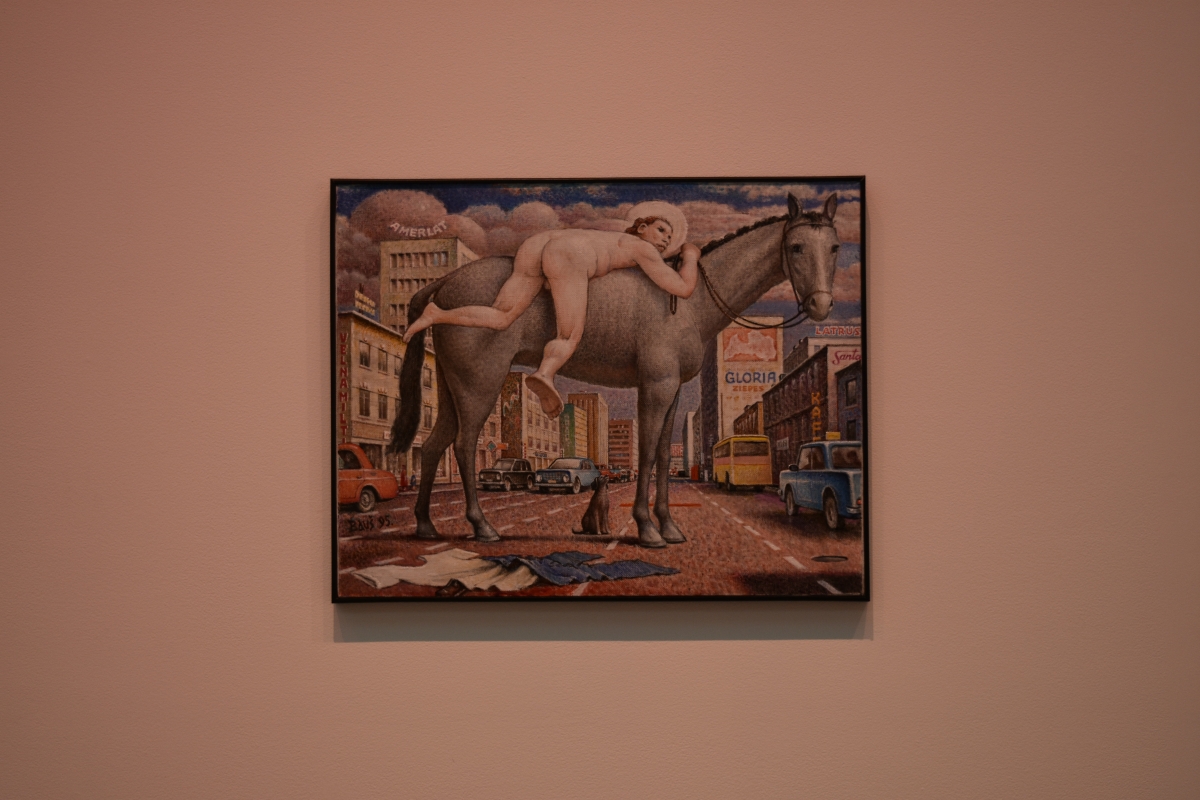
Installation view Balticana, Hessel Museum of Art, Photo: Pierre Le Hors 2019.

Performance by Vytautas Jurevicius during opening of Balticana, Hessel Museum of Art, Photo: Lisa Quinones 2019.

Performance by Vytautas Jurevicius during opening of Balticana, Hessel Museum of Art, Photo: Lisa Quinones 2019.

Installation view Balticana, Hessel Museum of Art, Photo: Pierre Le Hors 2019.

Installation view Balticana, Hessel Museum of Art, Photo: Pierre Le Hors 2019.
